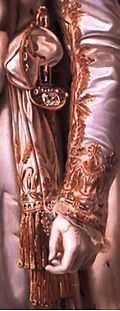Regent Diamond
_black.png) Regent Diamond | |
| Weight | 140.64 carats (28.128 g) |
|---|---|
| Colour | White with pale blue |
| Cut | Cushion |
| Country of origin | India |
| Mine of origin | Kollur Mine, Guntur District, Andhra Pradesh |
| Date discovered | 1698 |
| Cut by | Harris, 1704-1706 |
| Original owner | Kollur Mine |
| Current owner | France (on display at the Louvre) |
| Estimated value | ~£48,000,000 |
The Regent Diamond is a diamond owned by the French state and on display in the Louvre. In 1698, a slave found the 410 carat (82 g) uncut diamond in Kollur mine (more specifically in Guntur District, Andhra Pradesh, India) and hid it inside a large wound in his leg.[1] An English sea captain stole the diamond from the slave and killed him and sold it to an Indian merchant.[2] Governor Thomas Pitt acquired it from a merchant in Madras in 1701, so it is sometimes also known as the Pitt Diamond.[3]
 Detail of Napoleon's portrait with sword |
Pitt bought the diamond for £20,400 (£2,888,790 as of 2015),[4], and had it cut into a 141 carats (28.2 g) cushion brilliant. After many attempts to sell it to various Members of European royalty, including Louis XIV of France, it was purchased by the French Regent, Philippe II, Duke of Orléans in 1717 for £135,000 (£17,915,120 as of 2015),[4]. The stone was set into the crown of Louis XV for his coronation in 1722 and then into a new crown for the coronation of Louis XVI in 1775. It was also used to adorn a hat belonging to Marie Antoinette. In 1791 its appraised value was £480,000 (£50,372,980 as of 2015),[4].
In 1792 during the revolutionary furor in Paris, "Le Régent," or the regent diamond, was stolen along with other crown jewels of France, but was later recovered. It was found in some roof timbers in an attic in Paris. The diamond was used as security on several occasions by the Directoire and later the Consulat, before being permanently redeemed by Napoleon Bonaparte in 1801.
Napoleon used it to unleash his sword, designed by the goldsmiths Odiot, Boutet and Marie-Etienne Nitot. In 1812, it appeared on the Emperor's two-edged sword, which was a work of Nitot. Napoleon's second wife, Archduchess Marie Louise of Austria, carried the Régent back to Austria upon his death. Later her father returned it to the French Crown Jewels. The diamond was mounted successively on the crowns of Louis XVIII, Charles X and Napoleon III.
Today, mounted in a Greek diadem designed for Empress Eugenie, it remains in the French Royal Treasury at the Louvre. It has been on display there since 1887.
Folklore
Due to numerous scandals, and the misfortune of those who have been in possession of the stone, the Regent Diamond is said to be cursed. [5] [6] [7]
Bibliography
- Brown, Peter Douglas. William Pitt, Earl of Chatham: The Great Commoner. Allen & Unwin, 1975
External references
- Photo
- Regent diamond history in "Great Diamonds of the Earth" by Edwin Streeter
Notes
- ↑ Deccan Heritage, H. K. Gupta, A. Parasher and D. Balasubramanian, Indian National Science Academy, 2000, p. 144, Orient Blackswan, ISBN 81-7371-285-9
- ↑ http://www.farlang.com/diamonds/streeter_great_diamonds/page_16
- ↑ Brown p.15
- ↑ 4.0 4.1 4.2 UK CPI inflation numbers based on data available from Gregory Clark (2014), "What Were the British Earnings and Prices Then? (New Series)" MeasuringWorth.
- ↑ http://www.toptenz.net/top-10-most-notorious-diamonds.php, ,
- ↑ http://www.kojewel.com/odd/supposedly-cursed-diamonds-the-regent.htm
- ↑ http://www.diamondslittleblackdress.co.za/the-worlds-most-notoriously-cursed-diamonds/